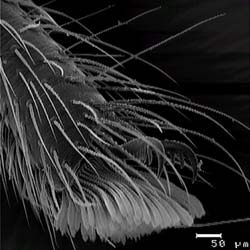Spiders make best ever Post-it notes

A scanning electron microscope (SEM) micrograph of the foot of the jumping spider E. arcuata. In addition to the tarsal claws, a tuft of hair called a scopula is found at the tip of the foot, which is what the spider uses to attach itself to surfaces. The long hairs which are distributed over the entire foot are sensitive to touch
Scientists have found that the way spiders stick to ceilings could be the key to making Post-it® notes that don’t fall off – even when they are wet. A team from Germany and Switzerland have made the first detailed examinations of a jumping spider’s ‘foot’ and have discovered that a molecular force sticks the spider to almost anything. The force is so strong that these spiders could carry over 170 times their own body weight while standing on the ceiling. The research is published today (Monday 19 April 2004) in the Institute of Physics journal Smart Materials and Structures.
This is the first time anyone has measured exactly how spiders stick to surfaces, and how strong the adhesion force is. The team used a scanning electron microscope (SEM) to make images of the foot of a jumping spider, Evarcha arcuata (pictures available – see notes). There is a tuft of hairs on the bottom of the spider’s leg, and each individual hair is covered in more hairs. These smaller hairs are called setules, and they are what makes the spider stick.
The paper reveals that the force these spiders use to stick to surfaces is the van der Waals force, which acts between individual molecules that are within a nanometre of each other (a nanometre is about ten thousand times smaller than the width of a human hair). The team used a technique called Atomic Force Microscopy (AFM) to measure this force. The flexible contact tips of the setules are triangular (pictures available – see notes), and they have an amazingly high adhesive force on the underlying surface.
Andrew Martin, from the Institute of Technical Zoology and Bionics in Germany, said, “We found out that when all 600,000 tips are in contact with an underlying surface the spider can produce an adhesive force of 170 times its own weight. That’s like Spiderman clinging to the flat surface of a window on a building by his fingertips and toes only, whilst rescuing 170 adults who are hanging on to his back!”
What makes the van der Waals force an interesting form of adhesion is that, unlike many glues, the surrounding environment does not affect it. The only thing that affects it is the distance between the two objects.
“One possible application of our research would be to develop Post-it® notes based on the van der Waals force, which would stick even if they got wet or greasy,” said Professor Antonia Kesel, head of the research group in Bremen. “You could also imagine astronauts using spacesuits that help them stick to the walls of a spacecraft – just like a spider on the ceiling.”
The total van der Waals force on the spider’s feet is very strong, but it is the sum of many very small forces on each molecule. The researchers believe the spider lifts its leg so that the setules are lifted successively, not all at once, and it does not need to be very strong to do this. All you would have to do to lift a future kind of Post-it® note is peel it off slowly.
The van der Waals force exists because the movement of electrons in atoms and molecules causes them to become dipolar. A dipolar atom or molecule has a “positive-pole” and a “negative-pole”. The positive-pole of one atom or molecule will be attracted to the negative-pole of another. This particular electrostatic attraction is called the van der Waals force, and is in some ways similar to the magnetic attraction between north and south poles of magnets.
“We carried out this research to find out how these spiders have evolved to stick to surfaces, and found that it was all down to a microscopic force between molecules. We now hope that this basic research will lead the way to new and innovative technology,” said Professor Kesel.
Media Contact
All latest news from the category: Physics and Astronomy
This area deals with the fundamental laws and building blocks of nature and how they interact, the properties and the behavior of matter, and research into space and time and their structures.
innovations-report provides in-depth reports and articles on subjects such as astrophysics, laser technologies, nuclear, quantum, particle and solid-state physics, nanotechnologies, planetary research and findings (Mars, Venus) and developments related to the Hubble Telescope.
Newest articles

Global Genetic Insights into Depression Across Ethnicities
New genetic risk factors for depression have been identified across all major global populations for the first time, allowing scientists to predict risk of depression regardless of ethnicity. The world’s…

Back to Basics: Healthy Lifestyle Reduces Chronic Back Pain
Low back pain is a leading cause of disability worldwide with many treatments, such as medication, often failing to provide lasting relief. Researchers from the University of Sydney’s Centre for Rural…

Retinoblastoma: Eye-Catching Investigation into Retinal Tumor Cells
A research team from the Medical Faculty of the University of Duisburg-Essen and the University Hospital Essen has developed a new cell culture model that can be used to better…



